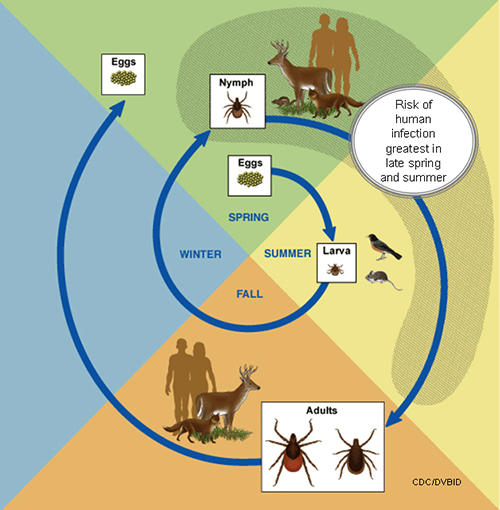Southern tick-associated rash illness pathophysiology
|
Southern tick-associated rash illness Microchapters |
|
Differentiating Southern tick-associated rash illness from other Diseases |
|---|
|
Diagnosis |
|
Treatment |
|
Case Studies |
|
Southern tick-associated rash illness pathophysiology On the Web |
|
American Roentgen Ray Society Images of Southern tick-associated rash illness pathophysiology |
|
FDA on Southern tick-associated rash illness pathophysiology |
|
CDC on Southern tick-associated rash illness pathophysiology |
|
Southern tick-associated rash illness pathophysiology in the news |
|
Blogs on Southern tick-associated rash illness pathophysiology |
|
Directions to Hospitals Treating Southern tick-associated rash illness |
|
Risk calculators and risk factors for Southern tick-associated rash illness pathophysiology |
Editor-In-Chief: C. Michael Gibson, M.S., M.D. [1] Associate Editor(s)-in-Chief: : Vishnu Vardhan Serla M.B.B.S. [2]
Pathophysiology
Most ticks go through four life stages: egg, six-legged larva, eight-legged nymph, and adult. After hatching from the eggs, ticks must eat blood at every stage to survive. Ticks that require this many hosts can take up to 3 years to complete their full life cycle, and most will die because they don't find a host for their next feeding.

Ticks can feed on mammals, birds, reptiles, and amphibians. Most ticks prefer to have a different host animal at each stage of their life, as shown below:

Ticks find their hosts by detecting animals´ breath and body odors, or by sensing body heat, moisture, and vibrations. Some species can even recognize a shadow. In addition, ticks pick a place to wait by identifying well-used paths. Then they wait for a host, resting on the tips of grasses and shrubs. Ticks can't fly or jump, but many tick species wait in a position known as "questing".
While questing, ticks hold onto leaves and grass by their third and fourth pair of legs. They hold the first pair of legs outstretched, waiting to climb on to the host. When a host brushes the spot where a tick is waiting, it quickly climbs aboard. Some ticks will attach quickly and others will wander, looking for places like the ear, or other areas where the skin is thinner.
The lone star tick, Amblyomma americanum, is found throughout the eastern, southeastern and south-central states. The distribution, range and abundance of the lone star tick have increased over the past 20-30 years, and lone star ticks have been recorded in large numbers as far north as Maine and as far west as central Texas and Oklahoma. All three life stages (larva, nymph, adult) of the lone star tick will feed on humans, and may be quite aggressive. Lone star ticks will also feed readily on other animals, including dogs and cats, and may be brought into the home on pets. The saliva from lone star ticks can be irritating; redness and discomfort at a bite site does not necessarily indicate an infection.
Transmission
Ticks transmit pathogens that cause disease through the process of feeding.
- Depending on the tick species and its stage of life, preparing to feed can take from 10 minutes to 2 hours. When the tick finds a feeding spot, it grasps the skin and cuts into the surface.
- The tick then inserts its feeding tube. Many species also secrete a cement-like substance that keeps them firmly attached during the meal. The feeding tube can have barbs which help keep the tick in place.
- Ticks also can secrete small amounts of saliva with anesthetic properties so that the animal or person can't feel that the tick has attached itself. If the tick is in a sheltered spot, it can go unnoticed.
- A tick will suck the blood slowly for several days. If the host animal has a bloodborne infection, the tick will ingest the pathogens with the blood.
- Small amounts of saliva from the tick may also enter the skin of the host animal during the feeding process. If the tick contains a pathogen, the organism may be transmitted to the host animal in this way.
- After feeding, most ticks will drop off and prepare for the next life stage. At its next feeding, it can then transmit an acquired disease to the new host.